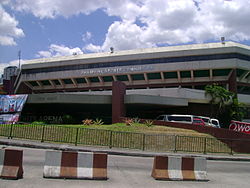 | |
| Full name | Philippine Institute of Sports Complex |
|---|---|
| Location | Pasig, Metro Manila, Philippines |
| Facilities |
|
| Construction | |
| Built | 1985 |
| Opened | 1985 |
| Renovated | 2010, 2012, 2015, 2019, 2025 |
| Tenants | |
| Philippine Sports Commission Philippine Olympic Committee | |
The Philippine Institute of Sports Complex (also known as the PhilSports Complex) is a national sports complex of the Philippines. It is located in Meralco Avenue in Pasig, Metro Manila, Philippines. It is where the offices of the Philippine Sports Commission, Philippine Olympic Committee and some national sports associations are located.
Contents
PhilSports Complex facilities are purposely built to cater the Filipino athletes’ needs from training facilities to living quarters. By virtue of Republic Act 6847, which created the Philippines Sports Commission, was to develop and maintain a fully equipped sports facility. Due to its proximity to business districts of Makati and Ortigas, the arena is also used in concerts and conventions.
